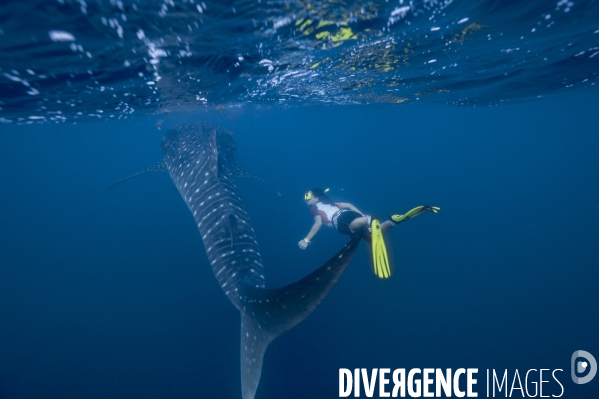
Requin baleine
© Alexis ROSENFELD / Divergence
Indian Ocean - Djibouti - Gulf of Tadjoura. The photographer decided to use powerful HMI lightings to attract, by night, the whale sharks (Rhincodon typus) to the pursuit of the plankton of which they eat. The biggest fish of the world is surrounded with a cloud of small fish, and of juvenile travellies, that lives in its wake. It can measure 18-meter long and can weigh 50 tons. It is part of the cartilaginous fishes, like rays and sharks. It evolves the most often between the surface and about hundred depth meters. Its big dark body is marked entirely more or less of white stains regular. The whale shark lives in the whole tropical zone of the three big oceans, but it seems that the most numerous population is in the Indian ocean. Discovered officially by Smith in 1828, the whale shark was always part of the species fished by the local populations: in Indonesia, it is still captured with harpoon, and eaten.It is protected today in Australia, in Maldives, and in the Filipino. Ocean Indien - Djibouti - Golfe de Tadjoura. Le photographe a décidé d'utiliser de puissants éclairages HMI pour attirer, de nuit, les requins baleines (Rhincodon typus) a la poursuite du plancton dont ils se nourrissent. Le plus grand poisson du monde est entouré d'une nuée de petits poissons, et de carangues royales juveniles, qui vivent dans son sillage. Il peut mesurer 18 mètres de long et peser 50 tonnes. Il fait partie des poissons cartilagineux, au meme titre que l'ensemble des raies et requins. Il évolue le plus souvent entre la surface et une centaine de mètres de profondeur. Son grand corps foncé est entièrement marqué de taches blanches plus ou moins régulières. Le requin baleine se retrouve dans toute la zone tropicale des trois grands océans, mais il semble que la population la plus nombreuse se trouve dans l'Ocean Indien. Découvert officiellement par Smith en 1828, le requin-baleine a toujours fait partie des espèces pêchées par les populations locales
Mots clés : ALIMENTATION, ANIMAL FILTREUR, APNEE, APNEISTE, BOUCHE, COMMENSALISME, COMPORTEMENT, DJIBOUTI, GOBER, GOLF D' ADEN, GOLF OF ADEN, GOLFE DE TADJOURA, MAGER, MASQUE, NAGER, NAGEUR, OCEAN INDIEN, PLANCTON, PLANCTONOPHAGE, PLANCTOPHAGE, RAYON DE SOLEIL, REQUIN, REQUIN BALEINE, RHINCODON TYPUS, TADJOURA, VIE MARINE, WHALE SHARK, behavior, indian ocean, marine life, shark